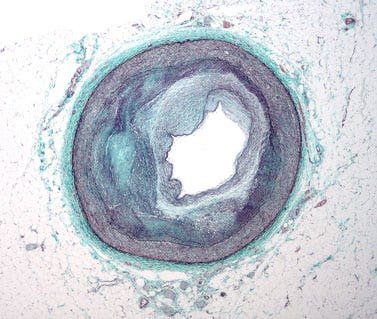
Using Small RNA Sequencing to Improve Diagnosis and Treatment of Coronary Artery Disease
November 2015

Using next-generation sequencing (NGS) and CleanTag® technology, French researchers discovered that a subclass of circulating small non-coding RNAs (sRNAs) is a biomarker for apoptotic lesional macrophages commonly associated with coronary artery disease (CAD). Currently, CAD lacks specific diagnostic criteria and is the leading cause of death worldwide. This discovery may enable a specific diagnostic avenue not previously available and aid in improving treatment through risk stratification.
"We are very close to predict, with just a blood withdrawal, if and when a heart attack may occur."
- Dr. Emanuela Repetto.
CAD develops when plaques build up in the coronary arteries. This process is called atherosclerosis and causes narrowing of the artery and restriction of blood flow to the heart (Image 1). Because CAD often develops over decades, symptoms can go unnoticed until it results in a heart attack. Previously, detection of CAD had been limited to classic cardiovascular risk factor or biomarkers, such as cholesterol levels, hypertension, and increased blood glucose. However, reduction of these risk factors does not fully prevent coronary events. Therefore, new methods for diagnosis and patient stratification are necessary.

Published last month in BMC Medicine, a research team led by Emanuela Repetto and Michele Trabucchi performed high-throughput small RNA NGS sequencing on primary macrophages that were followed by studies in animal models. Combined, the studies suggested that Ro-associated noncoding RNA-derived small RNAs (s-RNYs) are significantly upregulated in models of atherosclerosis, specifically stemming from apoptotic macrophage-derived foam cells. s-RNYs are ~24-34 nt and processed from full-length RNYs (also called Y-RNAs; ~110 nt) upon pro-apoptotic or pro-atherogenic stimuli.
These results were validated in humans with CAD, where they performed RT-qPCR to check the expression of circulating sRNYs compared to healthy age-matched individuals. Specifically, they found that s-RNY1-5p and s-RNY4-5p were increased while s-RNY3-5p was undetectable (Figure 1). To determine whether this increase was specific to CAD pathogenesis, they assessed the correlation of s-RNY1-5p levels with traditional cardiovascular risk factors, many of which are markers of general systemic inflammation. They concluded that s-SRNY1-5p levels are independent of these general markers, which indicates that s-RNYs may be a specific biomarker for the local inflammatory process occurring in atherosclerotic lesions in CAD.
"s-RNY1-5p is our magnifier of macrophage
apoptosis in atherosclerotic plaques."
? Dr. Repetto
Overall, the authors conclude that high serum s-RNY levels are strong indicators of CAD risk. Furthermore, s-RNY1-5p levels were shown to be independent of any other general cardiovascular risk factors, making them an ideal candidate for CAD diagnosis and risk stratification.
Featured TriLink Product: CleanTag Ligation Kit for Small RNA Library Preparation was used for input samples of 50 ng. For more information on CleanTag, contact us..
Have a question? Visit Ask An Expert.

